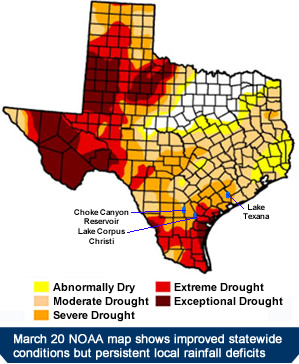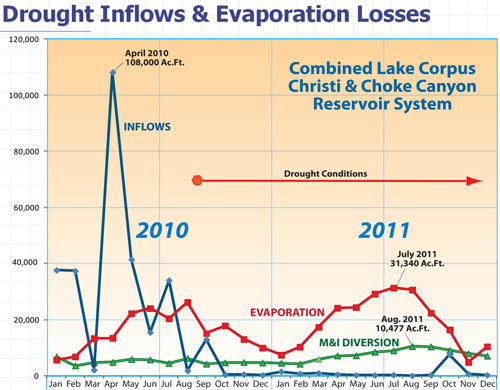Lake Texana Back to 100% Capacity While Choke Canyon/Lake Corpus Christi Hold Steady and Brutal 2011 Texas Drought Improves
March 24, 2012
Substantial beneficial rainfall during the opening months of 2012 have improved water supply conditions substantially particularly at Lake Texana which provides about half of the water used each year by Water District customers. 
Rains that caused flooding conditions in Houston on March 19 and 20 were widespread over the Lake Texana watershed and the lake filled to 100% of capacity on March 23. Lake Texana hit a record low level of 37% in early January and water deliveries were curtailed for several weeks as the Lavaca-Navidad River Authority implemented drought management policies.
There has been less rainfall in the Nueces, Frio and Atascosa river watersheds which feed Choke Canyon Reservoir and Lake Corpus Christi. The combined total water in storage in the two reservoir system has remained steady since the first of the year at between 51% and 54% of capacity.
Statewide the Drought of 2011 has moderated dramatically in recent weeks but remains severe in some portions of the state including the Coastal Bend. The accumulated rainfall deficit in the San Patricio County area over the past 18 months is approximately 23 inches.
Recent rains have improved soil moisture conditions in central San Patricio County and allowed planting of cotton, sorghum and corn. A mild winter and rains have improved pasture conditions and filled some stock ponds. Outdoor burn bans have been lifted in area counties.
La Nina conditions over the equatorial Pacific are gradually coming to an end. The long-term forecast calls for this to continue with near normal weather conditions expected by the end of April. This could result in more frequent rainfall in the Bay Area.
The Drought Management Plan for the Bay Area water supply system is triggered when the combined amount of water in storage in Choke Canyon and Lake Corpus Christi drops below 50%. This trigger was adopted before water from Lake Texana became available in 1998. The region has been buying up to 53,800 acre feet of water a year from Lake Texana and the Water District gets about half of its raw water from that source.
A change to the Drought Management Plan is being discussed which would account for the water available from Lake Texana in the calculation of the 50% trigger. That would have the effect of delaying the start of each of the three increasingly restrictive sets of water use rules.
The chart below shows that inflows to the Lake Corpus Christi/Choke Canyon system have been very low since early in 2010. It also depicts the fact that more water is lost each year to evaporation that is used by all municipal and industrial (M&I) customers of the system. Evaporation losses were particularly high during the summer months of 2011 when temperatures were high and humidity levels were lower than usual. All numbers shown are in acre feet of water (325,851 gallons per acre foot).

DROUGHT WATER RULES
Triggers in the Drought Management Plan are activated at 50%, 40% and 30% of system storage capacity. When the reservoir system storage drops below 50% of total system capacity, local water provider are to issue a public notice to inform water users to take greater voluntary conservation measures.
When capacity drops to 40% water providers will implement mandatory restrictions including time of day outdoor watering restrictions. Residents and businesses will be restricted from using water for irrigation of vegetation between the hours of 10:00 a.m. and 6:00 p.m. Under the 40% restrictions no person may: (1) allow water to run off from yards or plants into gutters or streets, (2) allow defective plumbing in a home or business to remain unaddressed or (3) allow water to flow constantly through a tap, hydrant, valve, or otherwise by any user of water connected to the municipal system. At 30% of reservoir capacity residential lawn watering will be sharply restricted to specific days in an effort to reduce demand further.








